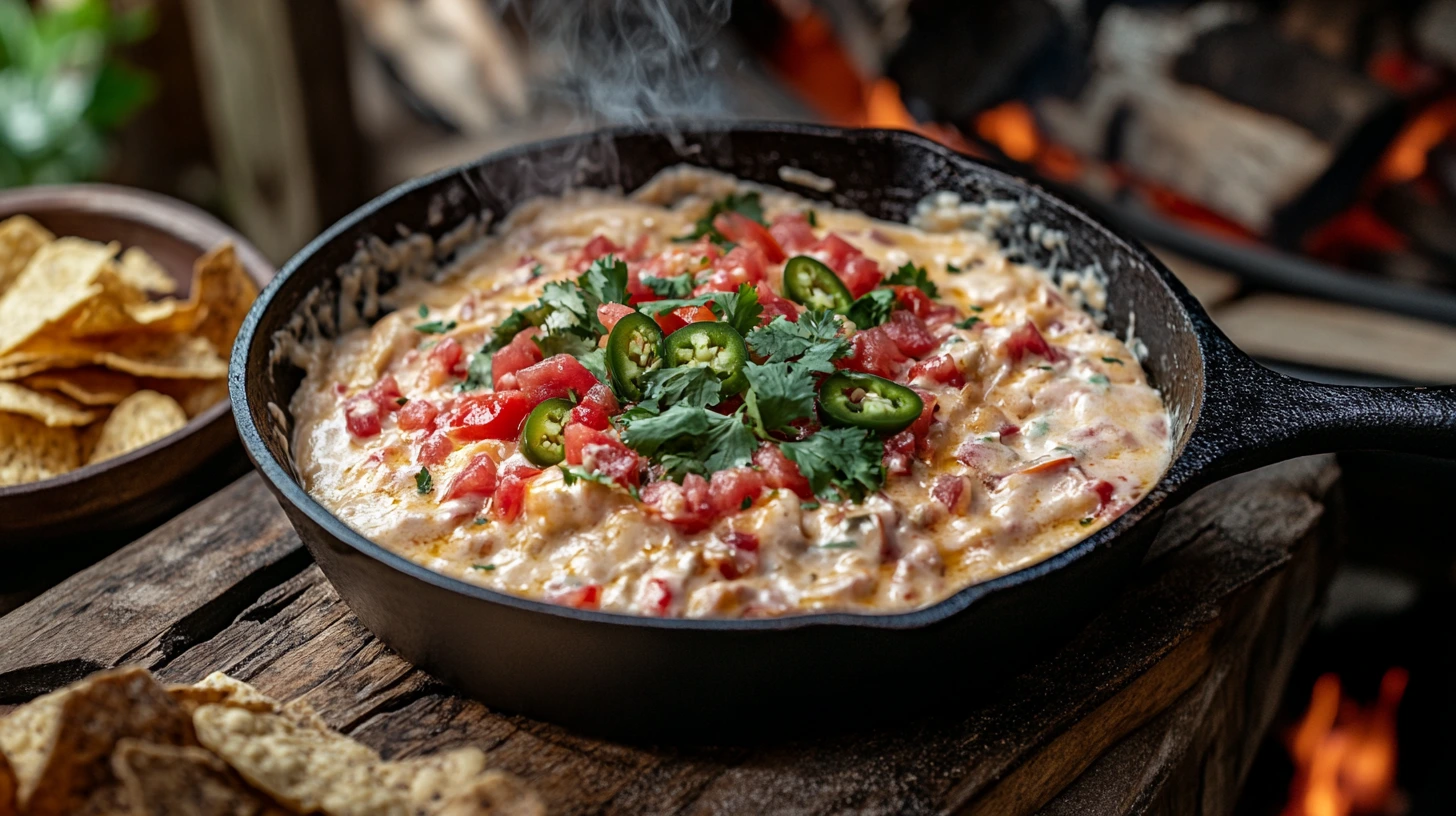Smoked queso has taken the culinary world by storm, becoming a favorite dish at backyard barbecues, tailgates, and family gatherings. This indulgent, melted cheese dip is elevated by the rich, smoky flavor imparted during the smoking process. Whether you’re a seasoned pitmaster or a beginner exploring the joys of smoking, selecting the right wood is a critical step to achieving the perfect smoked queso.
Wood choice isn’t just about fueling the smoker—it’s a defining factor in the flavor profile of the queso. Different woods produce unique smoke intensities, aromas, and tastes that can either complement or overpower the dish. With smoked queso’s delicate balance of creamy cheeses, spices, and optional add-ins like meats and vegetables, choosing the right wood can transform an ordinary dip into a gourmet masterpiece.
In this article, we’ll dive deep into the art and science of pairing wood with smoked queso. You’ll learn about the best wood types, their flavor profiles, and how to match them with your queso ingredients. Whether you’re after a subtle sweetness or a bold smoky punch, we’ll help you make the perfect choice to delight your taste buds and impress your guests. Let’s get started!
Table of contents
The Basics of Smoked Queso
What Is Smoked Queso?
Smoked queso is a mouthwatering variation of traditional queso dip that incorporates the rich, smoky flavors created by slow cooking over wood smoke. Typically made with a blend of cheeses, milk, or cream, and a variety of savory ingredients like tomatoes, peppers, and meats, smoked queso adds a new layer of complexity to the classic recipe. The result is a warm, gooey, and flavorful dip that pairs perfectly with tortilla chips, veggies, or bread.
The smoky aroma enhances every bite, making it an irresistible treat at barbecues or parties. Smoking queso doesn’t just melt the cheese—it infuses it with an unparalleled depth of flavor that makes it stand out.
Ingredients Typically Used in Smoked Queso
The beauty of smoked queso lies in its versatility. Here are the staple ingredients used in most recipes:
- Cheeses: Velveeta, cheddar, Monterey Jack, pepper jack, or mozzarella.
- Liquid Base: Milk, cream, or even beer for added depth.
- Meats: Chorizo, ground beef, or smoked bacon.
- Vegetables: Diced tomatoes, green chiles, onions, and jalapeños.
- Seasonings: Paprika, cumin, garlic powder, and chili powder.
Many people experiment with additional toppings like black beans, corn, or avocado to customize their queso.
Equipment Needed to Prepare Smoked Queso
Before diving into the smoking process, ensure you have the right equipment on hand. Here’s a list of essentials:
- Smoker: Whether you use a pellet grill, charcoal smoker, or electric smoker, any setup capable of low and slow cooking works.
- Wood Chips or Chunks: Choose wood types based on your desired flavor profile.
- Cast-Iron Skillet or Aluminum Pan: A durable container to hold the queso mixture and withstand prolonged heat.
- Mixing Tools: A spatula or spoon for stirring the queso as it smokes.
- Thermometer: To monitor the smoker’s temperature and ensure consistent results.
The Appeal of Smoked Queso
What makes smoked queso so appealing is the perfect harmony of creamy textures and smoky, savory flavors. The smoking process doesn’t just enhance the cheese—it ties together all the ingredients, creating a cohesive and flavorful dip that stands out on any table. Whether it’s the centerpiece of a party spread or a side dish for grilled meats, smoked queso is a crowd-pleaser that delivers every time.
Why Wood Selection Matters
The Science of Smoke and Flavor
When it comes to smoking, wood serves as more than just a fuel source—it’s the foundation for the smoky flavors that define dishes like smoked queso. The smoke produced by burning wood contains compounds like syringol and guaiacol, which contribute to the taste and aroma of smoked foods. Different wood types release varying amounts of these compounds, influencing the flavor profile of the queso.
For a dish as rich and creamy as queso, the smoke needs to complement rather than overpower. Too strong a wood can dominate the delicate flavors of the cheeses and ingredients, while too mild a wood may leave the queso tasting flat. Striking the right balance is essential.
How Different Woods Contribute to Unique Tastes
Each type of wood has its own flavor characteristics, ranging from sweet and fruity to bold and intense. Understanding these profiles helps you pair the right wood with your queso:
- Mild Woods: Such as alder or maple, these woods add a subtle, sweet smoke that won’t overshadow the queso’s primary ingredients.
- Fruity Woods: Like apple and cherry, these impart a slightly sweet and tangy flavor, which works well with cheeses and vegetables.
- Bold Woods: Hickory and mesquite produce robust, earthy smoke that pairs well with hearty ingredients like chorizo or bacon.
Impact of Wood Intensity on Queso
The intensity of the wood you choose can greatly affect the final dish. Here’s a quick breakdown of how different intensities interact with smoked queso:
- Light Intensity: Ideal for a queso that highlights the natural flavors of its cheeses and vegetables.
- Medium Intensity: Balances smoke with other flavors, making it suitable for recipes with meat and spiced additions.
- Heavy Intensity: Adds a strong, smoky character, perfect for bold, spicy queso blends but should be used sparingly.
Balancing Smoke with Ingredients
Choosing the right wood is all about creating harmony between the smoke and the ingredients in your queso. For example:
- A mild wood like alder might pair beautifully with a creamy cheese base and subtle spices.
- Sweet woods like apple or cherry can elevate the natural sweetness of tomatoes and peppers.
- Stronger woods like hickory are best reserved for queso recipes that include robust meats like bacon or chorizo.
By tailoring your wood choice to the ingredients, you ensure every element shines, resulting in a smoked queso that’s perfectly balanced.

Types of Woods for Smoking Queso
Selecting the right wood is one of the most critical steps in preparing smoked queso. Each wood type brings its own unique flavor to the dish, enhancing the natural richness of the ingredients. Below, we’ll explore the best woods for smoking queso, categorized by flavor profiles, along with tips for achieving the perfect balance.
Mild Woods for Subtle Flavors
If you prefer a delicate smoky flavor that lets the ingredients in your queso shine, mild woods are an excellent choice. These woods add just enough smokiness without overwhelming the cheese or vegetables.
- Alder: Known for its light and slightly sweet flavor, alder is a go-to option for queso recipes with milder cheeses like Monterey Jack or mozzarella. It complements vegetables like tomatoes and onions, making it a versatile choice.
- Maple: This wood delivers a mild, sweet smoke with hints of caramel. Maple pairs beautifully with creamy cheeses and adds a subtle depth to queso with ingredients like green chiles or mild sausages.
Sweet Woods for Balanced Notes
Sweet woods add a fruity, tangy undertone that works exceptionally well with smoked queso. They enhance the natural sweetness of ingredients like tomatoes, bell peppers, and some cheeses.
- Apple: Applewood is a classic choice for its light, fruity flavor. It’s ideal for queso recipes featuring cheddar or gouda, as it adds a touch of sweetness that balances the richness of the cheese.
- Cherry: Slightly more robust than apple, cherrywood adds a sweet, tangy flavor with hints of fruitiness. It’s perfect for queso recipes with a kick of spice, such as those using pepper jack cheese or jalapeños.
Bold Woods for Robust Tastes
For those who love a strong, smoky flavor, bold woods like hickory and mesquite are excellent options. These woods work best with queso recipes that include hearty meats and bold spices.
- Hickory: Hickory is one of the most popular woods for smoking, known for its bold, bacon-like flavor. It pairs wonderfully with queso that includes chorizo, ground beef, or smoked bacon. However, use it sparingly, as it can quickly overpower more delicate ingredients.
- Mesquite: This wood delivers an intense, earthy smoke that’s perfect for Southwestern-inspired queso recipes. It pairs well with bold spices like cumin and chili powder, creating a smoky dip with a powerful punch.
Blended Wood Combinations
For a more complex flavor profile, consider blending different woods. Combining mild and bold woods allows you to customize the intensity and balance of smoke in your queso.
- Apple + Hickory: This mix combines the fruity sweetness of apple with the robust smokiness of hickory, perfect for queso with both vegetables and meats.
- Cherry + Mesquite: The tangy notes of cherry mellow out the strong, earthy flavor of mesquite, creating a balanced yet bold smoked queso.
- Maple + Alder: For a lighter, sweeter smoke, blend these two mild woods to enhance the creaminess of your queso without overpowering its subtler flavors.
Factors to Consider When Choosing a Wood
- Cheese Type: Milder cheeses benefit from light or sweet woods, while sharper cheeses can handle stronger woods.
- Additional Ingredients: Meaty queso recipes pair well with bold woods, while vegetarian versions shine with fruity or mild woods.
- Personal Preference: Don’t be afraid to experiment with wood combinations to create your ideal flavor profile.
By understanding the unique properties of each wood type, you can tailor your choice to suit your ingredients and desired flavor intensity.
Pairing Wood Types with Queso Ingredients
Selecting the right wood for smoking queso isn’t just about the wood itself—it’s also about how it complements the ingredients in your recipe. From cheeses to meats to vegetables, different components of smoked queso shine best when paired with specific wood flavors. Let’s explore the perfect wood pairings for the most common ingredients in smoked queso.
Matching Woods to Cheeses
Cheese is the star of queso, and its flavor plays a pivotal role in determining which wood to use. Here’s a guide to popular cheeses and their ideal wood pairings:
- Cheddar: This sharp, robust cheese pairs well with hickory or applewood. Hickory adds a bold smokiness, while apple balances the richness with a touch of sweetness.
- Monterey Jack: A mild cheese like Monterey Jack benefits from lighter woods like alder or maple. These woods enhance the creaminess without overpowering the flavor.
- Pepper Jack: Spicy and bold, pepper jack thrives with medium-to-strong woods like cherry or mesquite. Cherry’s sweetness tempers the heat, while mesquite amplifies the smoky notes.
- Velveeta: As a processed cheese with a smooth, creamy texture, Velveeta pairs beautifully with mild woods like alder or sweet woods like apple.
Wood Pairings for Meats
Many smoked queso recipes feature savory meats that bring richness and heartiness to the dip. Pairing the right wood with these meats can elevate the overall flavor:
- Chorizo: This spicy, smoky sausage works well with bold woods like mesquite or hickory. These woods enhance chorizo’s robust flavor and complement the spices.
- Ground Beef: A versatile meat, ground beef pairs well with medium woods like cherry or a combination of apple and hickory. The blend balances the smokiness with a slight sweetness.
- Bacon: The natural smokiness of bacon pairs perfectly with hickory, which intensifies its flavor. For a milder option, try a blend of apple and cherry woods.
Best Woods for Vegetable Additions
Vegetables like peppers, onions, and tomatoes add freshness and texture to smoked queso. The wood you choose can highlight their natural flavors:
- Tomatoes: Sweet woods like apple or cherry bring out the natural sweetness in tomatoes, enhancing their rich, slightly tangy flavor.
- Bell Peppers: Maple or alder adds a subtle smokiness to bell peppers without overwhelming their mild sweetness.
- Jalapeños: For a spicy kick, jalapeños pair well with stronger woods like mesquite or cherry. These woods add depth while balancing the heat.
- Onions: Onions absorb smoke beautifully, and a medium wood like cherry or maple enhances their natural sweetness.
Customizing Flavor Profiles with Add-Ins
If your smoked queso recipe includes unique add-ins, you can customize the wood choice to match these flavors:
- Beans (Black Beans or Pinto): Sweet woods like apple or cherry complement the earthy flavor of beans, adding a layer of complexity.
- Corn: The natural sweetness of corn pairs well with maple or applewood, which enhances its sugary notes.
- Spices (Cumin, Chili Powder): Bold woods like mesquite amplify the smoky essence of spices, creating a more robust queso.
Tips for Achieving Balance
- Start Mild: If you’re unsure, begin with a lighter wood like alder or maple and gradually experiment with stronger options.
- Blend Woods: Create depth by mixing a fruity wood like cherry with a stronger one like hickory.
- Consider Cooking Time: Longer smoking times may intensify the flavor, so adjust the wood intensity accordingly.
Smoked queso is versatile and can be paired with various dishes for a complete meal. Learn more about how to make the perfect smoked queso.
For an unforgettable meal, serve smoked queso alongside Southern cornbread to enhance the smoky, creamy notes.
Additional Serving Ideas
Pairing smoked queso with fresh salads adds balance to the meal. Consider trying it with Mexican chicken salad for a flavorful and nutritious option.
FAQs
What is the best wood for smoky but mild queso?
For a smoky yet mild flavor, maple and alder are excellent choices. They provide a subtle smokiness that enhances the cheese without overwhelming it, making them ideal for recipes with milder ingredients.
Can I use pellet smokers for smoked queso?
Yes, pellet smokers are a fantastic option for smoking queso. They allow for precise temperature control and offer a variety of flavored pellets, such as apple, cherry, and hickory, to customize the smoke profile of your queso.
What wood should I avoid when smoking queso?
Avoid using woods like pine, cedar, or eucalyptus, as they contain resins that produce bitter, unpleasant smoke and can even be toxic. Stick to hardwoods that are safe for smoking food.
Is there a difference in flavor between chips and chunks?
Yes, there’s a difference. Wood chips burn quickly and produce a lighter, less intense smoke, while wood chunks burn slower and generate more robust, longer-lasting smoke. Chunks are ideal for longer smoking sessions, like with queso.
How long should I smoke queso for the best results?
Smoke queso for 1-2 hours at a temperature of 225°F to 250°F. This duration ensures the queso absorbs enough smoky flavor while maintaining the creamy texture of the cheese.
Can I mix different woods to create a unique flavor?
Absolutely! Mixing woods like apple and hickory or cherry and mesquite allows you to create a complex and balanced flavor. Experiment with combinations to find the perfect blend for your queso.
Conclusion
Smoked queso is more than just a dip—it’s a flavorful centerpiece that showcases the art of barbecue. Choosing the right wood plays a pivotal role in elevating this dish, whether you prefer the light sweetness of apple or the bold intensity of hickory. By tailoring your wood choice to your ingredients, you can create a harmonious balance that enhances the flavors of your queso.
Experimentation is key to discovering your ideal smoked queso recipe. Whether you’re blending wood types, trying regional twists, or adding unique ingredients, the possibilities are endless. With the right wood and a touch of creativity, your smoked queso will be a crowd-pleaser at any gathering.
Now it’s time to fire up your smoker, choose your wood, and create a queso masterpiece that’s rich, creamy, and unforgettable. Enjoy the smoky goodness!

